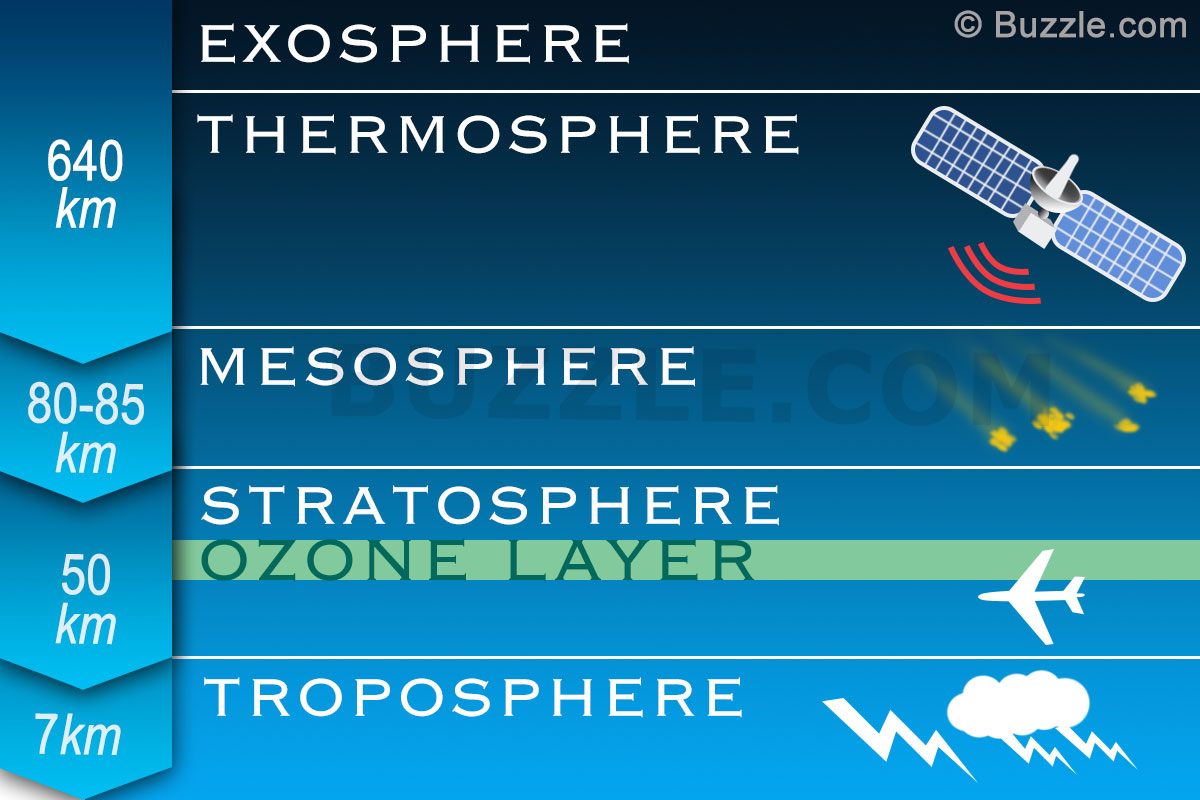
Composition of the atmosphere
Atmosphere is an envelope of gases. The height of the
atmosphere is estimated between 16-29 thousand km from the sea level. The air is
mechanical a mixture of several gases. The atmosphere is composed of gases
vapour and particles.The enveloping mixture of gases contain huge no. of solid and liquid particles collectively called Aerosols.
Gases
Nitrogen (78%), oxygen( 21% ) major gases of atmosphere. The remaining 1% is
represented by argon (0.93%) carbon dioxide (0.03%) Neon (0.0018%), helium
(0.0005%)
Ozone (0.00006%) hydrogen, Krypton and methane etc.Also see in the table
Water Vapour
The water vapour contained in the atmosphere
range between 0 and 5% by volume. The atmospheric vapour is received through
the evaporation of moisture and the water from the water bodies like Seas and
ocean, vegetation and soil covers it's depend on Temptation and decrease from
the equator poleward in response to decrease in temperature toward the poles.
The moisture content in the atmosphere contain sale of forms of condensation
and precipitation e. g.
Clouds, Fogs, dew, rainfall, Frost, hailstorm,Ice,
snowfalls etc.
Structure of Atmosphere
The height of the atmosphere is up to 800 km. About
50% of the atmosphere lies below the altitude of 5.6 km and 97% of the
atmosphere is confined to the height of only 29 km . On the basis of
characteristic of temperature and the air pressure There are several layers
from the Earth surface upward.
Troposphere
Lowest layer of atmosphere is known as troposphere. It is most important
layer because almost all of the weather phenomena occur in this layer.
Temperature decrease with increasing height at the rate of 6.5 % per 1000 m.
This rate of decrease of temperature is called Normal lapse rate. The average
height of the atmosphere is about 15 km over the equator and 6Km over the poles.
The upper limit of the troposphere is called tropopause which is about 1.5 km.
The word troposphere means "zone or region of mixing" whereas the word
tropopause means "where the mixing stop".
Stratosphere
The layer just above the atmosphere is called stratosphere.
The lower part of this layer is very important for life forms in the biospheric ecosystem because there is concentration of ozone between the height
of 15 to 30 km. The lower portion of the stratosphere having maximum
concentration of the Ozone is called the ozonosphere between height of 15 km
to 35 km from the sea level.
Ozone(O3)define as a three atom isotope of oxygen it's a blue
irritating gas with pungent odour. It's act as a protective cover for the
biological communities from the ultraviolet rays of solar radiation. It may be
result of oxygen with individual oxygen molecules result in the creation of
ozone O2 + o → O3. There is gradual depletion of the ozone gas in the
atmosphere due to increase in gases e. g. chlorofluorocarbon, carbon dioxide
and nitrogen oxide. When chlorofluorocarbon reacts with water and thus depletes
Ozone weather breaks Ozone into O2 and o. This would cause global warming, acid
rain melting of Continental glaciers and rise in sea level, skin cancer to white-skinned people, poisonous smoke, decrease in photosynthesis, ecological disaster and
ecosystem instability.
.
Mesosphere
Mesosphere extends between 50 km and 80 km and the temperature again
decrease with increasing height. In fact rise of the temperature with
increasing height in the stratosphere stopped at stratopause. The upper most
limit of the mesosphere (80 km) temperature become -80 degree centigrade
is called mesopause.
Thermosphere
The part of the atmosphere beyond mesopause is known as thermosphere. The temperature increase rapidly with increasing height. The temperature cannot
be measured by ordinary thermometer because the gases become very light due to
the extreme low density.
Thermosphere is divided into two layer ionosphere and exosphere
Ionosphere
It extends from 80 km To 640 km. The number of ionic
layer with increasing heights in this sphere e.g.
- D layer
- E layer
- F layer
- G layer
The layer between the height of 60 km 99 kilometre reflect the signals
of low frequency radio waves but absorb the signal of medium and high frequency
wave. This layer disappear with the sunset because it is observed with solar
radiation.
E Layer also known as kennelly -Heaviside layer,, height between 99 km
130 km. This layer reflects the medium and high frequency radio waves back to
the earth. This layer is produced due to interaction of the Solar ultraviolet
Photon with nitrogen and nitrogen molecule and also disappear with the sunset.
Sporadic E layer is associated with high velocity means this layer
reflective very high frequency radio wave.
E2 layer is generally found at height of 150 km and produced due to
reaction of the ultraviolet solar photons with oxygen molecules and also
disappear during Nights.
F layer consists of two sub-layer
F1 and F2 layers( 150 km 380 km) are Appleton layer.. These layer
reflect medium and high frequency radio wave back to the earth.
G layer 400 km and above most probable persist day and night but
is not detectable.
Exosphere
It's a uppermost layer of the atmosphere .In fact we know very little
about the atmosphere extends beyond 640 km height from the sea level. the
density become extremely low the temperature become 5568 degree Celsius at this
outer limit but this temperature is different from the air temperature of the
Earth surface as it is never felt.
plz Visit Atmosphere of Earth part 2
https://nikitanirmalgeoinformation.blogspot.com/2018/10/atmosphere-of-earth-part-2.html

